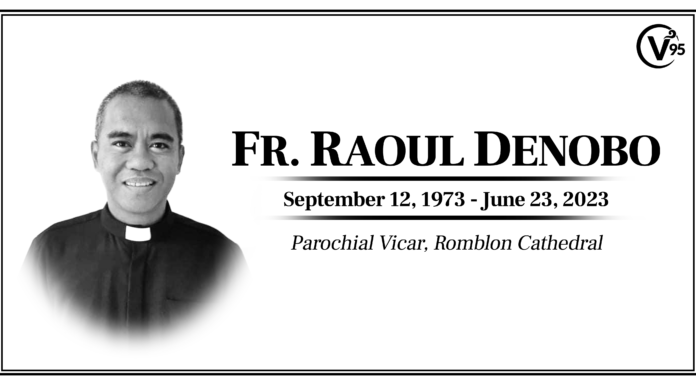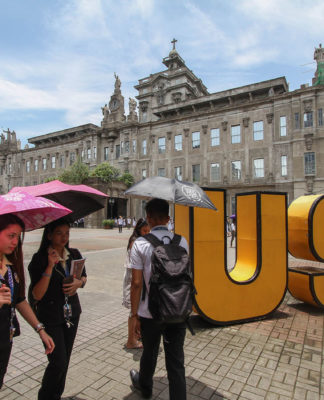JOURNALISM and writing are best learned through practical lessons, but who would mind getting tips from some the biggest names in Philippine media?
The 13th edition of Inkblots, the annual campus journalism fellowship organized by the Varsitarian, once again gathered prominent media practitioners, this time, under the theme “Uncover the Truth.”
From Oct. 13 to 15 at the Thomas Aquinas Research Complex, some 200 fellows from all over the country interacted with speakers and were shown “how the pros do it.”
This year’s keynote speaker, former senator Aquilino Pimentel Jr., opened Inkblots with an anti-reproductive health (RH) bill lecture delivered before more than 200 fellows.
“Life is the utmost human right that a person could ever have,” he said, adding that the RH bill is “invading the arena” of human rights through its advocacy of free-flowing contraceptives and abortifacients.
Pimentel further emphasized the importance of freedom of expression and respect, saying that, “in our free and democratic society, there is room for differences and opinion, especially among you who are writers.”
Palanca award-winning poet and TV5 host Lourd De Veyra delivered an inspirational message that enthused the fellows’ passion for their craft.
De Veyra, a UST Journalism alumnus and former Varsitarian literary writer, reminisced how the late Ophelia Dimalanta, his professor in Creative Writing, awakened his passion for writing.
“Do not find a teacher for your craft only, but find a teacher who could lecture you about life…once you discover what you want to do in life, there is no other lesson that you need,” he said.
De Veyra encouraged aspiring writers to always read, write, and revise.
“Do not think that the initial output of your writings and feelings is the final product of your craft,” De Veyra told the fellows as he emphasized the importance of doing regular writing exercises.
“The only way to learn how to write is to just write,” he said, quoting an old but powerful adage.
Tricks of the trade
Philippine Daily Inquirer reporter and former Varsitarian editor in chief Christian Esguerra discussed the fundamentals of news writing.
“It is accurate, as close to the truth as possible,” he said. “It is interesting, if not exciting. The real story is in the details and the beauty in the narrative. Strive to convey singular, related thought in the same paragraph.”
“News writing is story-telling,” he added. “It is arguably the best and easiest way to tell a story.”
He mentioned that news writing could only be learned over time, through constant practice because there is no such thing as a perfect news article.
“Write as soon as you are done gathering details. Do not make the article wait,” he said. “Go deeper; do not just scratch the surface.”
Philippine Daily Inquirer columnist Rina Jimenez-David shared the basics of editorial and opinion writing by recalling her two-decade stint as a newspaper columnist.
She said opinion writing is not just a “vanity trade” wherein columnists inflate their egos.
“To be a successful columnist or opinion writer, your writing must resonate with your readers,” the former editor in chief of the Varsitarian said.
As parting words, she advised young journalists to always read books to enhance their writing skills.
“Carefully choose the people you read, and read a wide variety of works. Be a voracious reader,” David said.
Manila Bulletin associate editor and former Varsitarian managing editor Nestor Cuartero tackled the fundamentals of feature writing. He explained that feature articles have a personal slant and are written in an individualistic approach.
“Features are not meant to deliver the news first-hand,” Cuartero said. “They do not contain elements of news, but their main function is to humanize, to add color, to educate, to entertain, and to illuminate.”
He added that there is no firm line between a news and a feature story, particularly in the contemporary media where many news stories are featurized.
Discussing broadcast journalism, GMA-7 reporter Cesar Apolinario said no matter how big or small a story is, it can still make an impact depending on how well it is produced and how well it is written.
“There is a story in everything, big or small,” he said.
Manifesto for the simple scribe
Fr. Nilo Lardizabal, O.P. delved into Catholic journalism, underscoring the responsibilities of a Catholic journalist.
“Our duty is to make journalism and the media share the gospel of truth, life, and love,” he said, adding that “it will reflect in your works if you are truthful and sincere.”
He noted journalists should convey the facts sincerely and be rooted in.
“It is more of seeking to inform and not just to trivialize. In a distantly proximate way, it has to convey the message of God,” Lardizabal said.
Consequently, Radyo Veritas commentator and Varsitarian staffer Fr. Nick Lalog, O.P. discussed Catholic journalism and journalism ethics by recognizing the implications of the power of media and communication today.
“Every communication must comply to certain requirements which are sincerity, honesty, and truthfulness. A communication must accurately reflect the situation with all its implications,” said Lalog, adding that the moral worth and validity of any communication does not lie solely on its intellectual content,” Lalog added.
“The total output of media in any given area should be judged by the contribution it makes to the common good of the community,” he said.
Dealing with layout and design, Ivan Anthony “Tony” Hirro said that readers get their first impression from the newspaper’s design as it is considered as its packaging.
Hirro, art director of Philippine Daily Expose and Samahang Kartunista ng Pilipinas director, also shared that there are no rules in layout—only trends, conventions, and standards.
“Grow a concept,” he said. “Design is all about concept and how to sell it to your editor, publisher, and reader.”
Mentioning that there should be a nice blend of reporting techniques backed up by research, UST professor Jeremaiah Opiniano, president of the OFW Journalism Consortium, said that in journalism research, a journalist should translate the technical survey data into real-life human experiences.
“Know and analyze actors involved,” he said. “Get views from people. Write something that challenges readers and give readers things to think about.”
He added that journalists do not just study results from surveys, experiments, and case studies, but they also find out what they mean to people, eventually humanizing the story.
Campus press issues
Business World research head and Varsitarian assistant publications adviser Felipe Salvosa III shared to the fellows tips and lessons on how to manage a campus publication through sharing some of the newsroom practices of the Varsitarian.
Salvosa emphasized that a school paper must also have an educational dimension wherein it will not only inform the whole school or community on events and issues surrounding them, but also educate the staff members of the publication on the different practices of journalism.
“You might think student publications are only for expression, but you must not forget the educational character of the school paper,” he said.
He also warned the fellows to be careful enough to avoid libel and even cited an instance wherein the Varsitarian was charged of it.
“At the college level, students are essentially free to do whatever they want within the limits of the law as long as they do not commit libel,” Salvosa said.
Other speakers in this year’s Inkblots included GMA-7 reporter Jun Veneracion for investigative journalism; sports analyst, commentator, and writer Quinito Henson for sports writing; cartoonist Manix Abrera for cartooning; Christine Violago of World Youth Alliance for Catholic journalism and journalism ethics; and Ateneo de Manila professor Gary Devilles for Filipino writing in campus journalism.
Fostering camaraderie
Kassandra Dajao, editor in chief of The Spectrum, the official publication of the University of Saint La Salle Bacolod, gave positive remarks about this year’s Inkblots speakers.
“We do not regret attending the conference,” she said, adding that she and her schoolmates enjoyed listening to the speakers and had a great time mingling with other fellows from different colleges and universities nationwide.
Furthermore, Inkblots first timer and Thomasian Pauline Tome said attending the three-day seminar was a way to improve every budding journalist’s skills.
Tome, a second year journalism student, added that Inkblots exceeded her expectations, stressing that the Photojournalism segment gave her new insights about photography.
“You think it is very simple at first, but it is really more than just taking pictures,” Tome said.
To conclude this year’s Inkblots, a fellowship night was held at the Plaza Mayor with Thomasian band Callalily gracing the night. Erika Denise L. Dizon and Azer N. Parrocha















